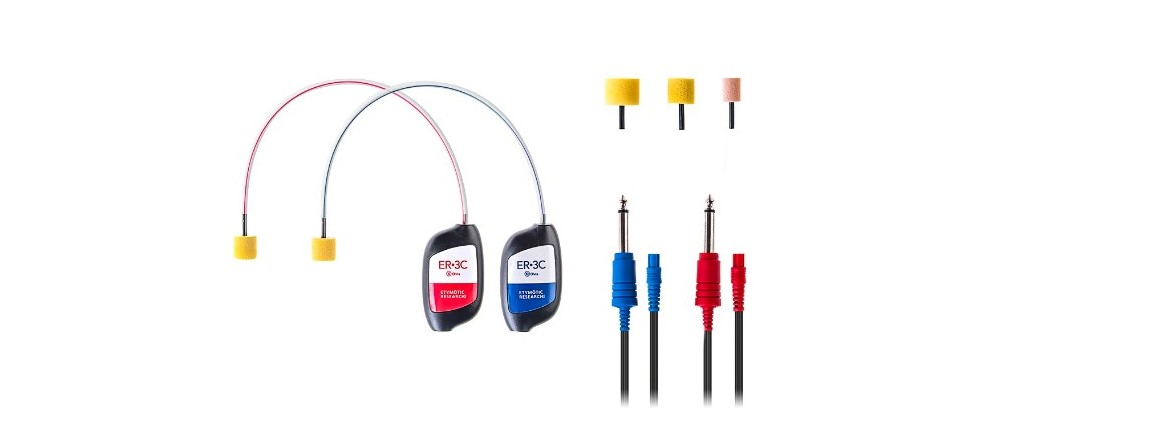Etymotic Research ER-3C Insert Earphones
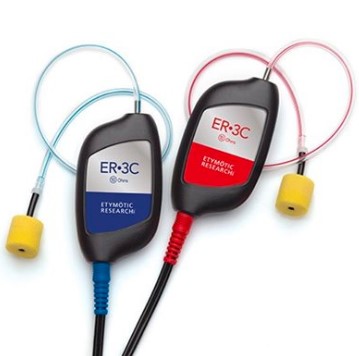
About Etymotic
Etymotic is a well-known audio technology business that specializes in high-quality earphones and hearing devices. Since its founding in 1983 by Dr. Mead Killion as a pioneer in audio technology, the firm has built a reputation for its dedication to accurate sound reproduction and hearing protection. Etymotic has earned the trust of audiophiles and professionals alike by focusing on research and innovation.
Their devices are intended to provide great sound quality while protecting consumers’ hearing health. These items have found applications in a variety of industries, including aviation, music, construction, and others, guaranteeing that people’s hearing is protected without affecting their ability to hear accurately.
INTRODUCTION AND INTENDED USE
ER-3C™ earphones are the latest generation of insert earphones by Etymotic Research, an update to Etymotic’s ER-3A® Tubephone earphones, which have been the worldwide standard for audiometric insert earphones since 1985.
ER-3C earphones are intended for use with audiometric equipment used in hearing testing in audiology clinics, auditory research and screening in industrial and educational settings. They are well suited for unfavorable test environments that may have high ambient noise levels. The frequency response and performance characteristics of ER-3C earphones are virtually identical to the original ER-3A earphones at all audiometric frequencies and approximate the frequency response of the supra-aural or circumaural headphones commonly used for audiometry.
Advantages of ER-3C earphones:
- Incorporates “touch-proof” electrical connection for safety
- Duplicates the ER-3A smooth frequency response
- 30+ dB external noise exclusion – equivalent to a single-wall booth when used with deeply-sealed foam ear tips
- 70+ dB isolation (interaural attenuation) between ears; reduces the need for masking
- Reduces test/retest variability compared to supra-aural or circumaural earphones
- Eliminates test errors due to collapsed ear canals
- Simplifies RECD (Real-Ear-to-Coupler-Difference) measurements
- It May be calibrated in a 2-cc coupler, occluded ear simulator, or 0.4-cc coupler
SYSTEM INCLUDES
- ER-3C earphones (10 Ohm,50 Ohm, or 300 Ohm)
- 7′ cable with dual-mono 6.3 mm (1/4″) plugs
- 20 foam ear tips (regular, 13 mm)
- 20 foam ear tips (small, 10 mm)
- 2 foam ear tips (large, 18 mm)
- Hook-and-loop neckstrap
WARNINGS
- Do not use insert earphones when medically contraindicated, e.g., draining ear, infection, ear canal laceration, or other otologic condition where the use of insert earphones could potentially exacerbate a medical condition.
- ER-3C earphones can produce high sound pressure levels. Use caution when selecting presentation level and duration.
- Reliable test results can be obtained with ER-3C earphones only when the audiometric equipment they are used with is calibrated before initial use and at subsequent intervals as specified by the audiometric equipment manufacturer, in compliance with national and international standards and regulations.
- ER-3C earphones are available in 10-Ohm, 50-Ohm, and 300-Ohm impedance. It is essential that the correct impedance be used in accordance with the specifications of the audiometric equipment. Labels on the earphones identify the earphone impedance.
- Use of accessories or replacement parts other than those supplied by Etymotic Research or its authorized distributors may result in inaccurate results.
- Modification or alteration of any parts may invalidate test results.
- Do not use in or near strong magnetic fields (e.g., MRI).
- Do not reuse ear tips. All ear tips, regardless of material or construction are for single-subject use only. Replace ear tips for each test session.
EARTIPS
- Foam ear tips are recommended for most uses. They are available in three sizes: standard 8-13 mm (ER3-14A), small 6-9 mm (ER3-14B), and large 1014 mm (ER3-14C).
- Infant ear tips are available in two sizes: (ER3-14D 3.5 mm and ER314E 4 mm). See page 10.
- Multiple sizes of Single Use Eartips™ 3 mm-16 mm (ER10D-T series) commonly used in immittance and otoacoustic emissions testing can be used with single-use ear tip adapters (ER3-06X).
No data are available on the interaural attenuation or noise exclusion of immittance ear tips.
All ear tips, regardless of material or construction are for single-subject use only. Replace ear tips for each test session. Do not reuse ear tips.
EARTIP COUPLING
Foam ear tips developed for ER-3C insert earphones have dimensions that ensure proper calibration and test accuracy.
- The length of black tubing from the end of the sound tube adapter through the foam ear tip is 26 mm. Do not cut the black tubing that connects the foam ear tip to the sound tube.
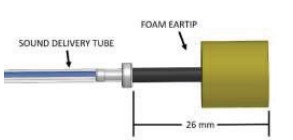
- To obtain the noise exclusion and interaural attenuation shown on pages 6-7, the insertion depth should be 14-15 mm into the ear canal. This depth is achieved when the outside edge of the foam ear tip is 2-3 mm inside the entrance to the ear canal.
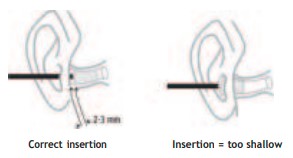
Notes
- Do not cut the sound delivery tube. A change of 10 mm in the length of the sound tube will change the frequency response by 0.5 dB at some frequencies.
- Replace the sound delivery tubes (ER3-21) if they crack or harden.
- Replace the sound delivery tubes (ER3-21) if they crack or harden.
- Calibration is maintained when using single-use ear tip adapters.
INSTRUCTIONS FOR USE
- Refer to the audiometer manual for instructions on properly connecting the earphones.
- Examine the ear canal for obstruction or excessive cerumen.
- Visually evaluate each ear canal to determine the appropriate size ear tip.
- Make sure the sound delivery tube is not blocked.
- Insert the black tubing of an ER3 foam ear tip completely onto the adapter of the sound delivery tube.

- To facilitate proper placement, firmly roll the foam ear tip into the smallest diameter possible.

- Insert the ear tip into the ear canal.
- The purpose of deeply inserted ear tips is to maximize interaural attenuation and noise exclusion.
- Correct insertion depth: When the outside edge of the ear tip is 2-3 mm inside the entrance of the ear canal.
- Allow foam to expand to acoustically seal the ear canal.
- Hold the ear tip in place until it expands.
- If correct insertion depth cannot be achieved, try rolling the foam into a smaller diameter before insertion. If unsuccessful, use a different size ear tip.
- If the seal is inadequate, try another ear tip
- Discard ear tips after each use.
Allowable A-weighted Room Noise During Audiometric Testing
The current ANSI Standard “Maximum Permissible Ambient Noise Levels (MPANLs) For Audiometric Test Rooms” [ANSI S3.1-1999 (R2013)] includes octave band and one-third of octave band permissible noise levels for both supra-aural and ER-3 Series insert earphones. See the ER-3C Calibration Manual for more information.
Room noise below 45 dBA should provide accurate audiometric testing to 0 dB HL. A room noise of 65 dBA should provide accurate screening to 20 dB HL.
Both of those guidelines depend on the use of a foam ear tip properly inserted as described on page 4, which provides an average external noise exclusion of approximately 40 dB, with a minimum of 36 dB at 2 kHz.
CALIBRATION
- Before calibration, confirm that the impedance of the earphones matches the requirements of the audiometric equipment. The labels on the earphones identify the impedance. Unless the audiometer was purchased with ER-3C earphones pre-calibrated by the audiometric equipment manufacturer, the Reference Equivalent Threshold Sound Pressure Levels (RETSPL) values and procedure cited in the current version of the ANSI S3.6 or IEC 60645-1 standard must be used to calibrate the equipment prior to initial use. Re-calibration should subsequently be performed at intervals specified by the audiometric equipment manufacturer, in compliance with national and international standards and regulations.
- Correction factors can be applied where it is necessary to alternate between insert earphones and supra-aural earphones with audiometers that do not provide a dual-calibration option.
CARE AND CLEANING
- Use a damp cloth to wipe down any parts that become soiled during normal use.
Antimicrobials (glutaraldehyde) are safe for external surfaces. Any other agents must be tested before use to prevent damage. - Do not submerge earphones in any liquid or allow liquid into the Sound delivery tubes.
- Do not use alcohol or other strong chemicals or solvents to clean Earphones or any parts, including cables, sound delivery tubes, and ear tips.
ACCESSORIES AND REPLACEMENT PARTS
Accessories and replacement parts are available from Etymotic Research and its authorized distributors.
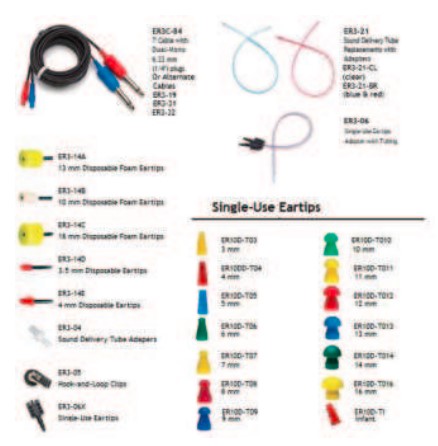
CABLE ATTACHMENT AND REPLACEMENT
Firmly insert the cable connector in the corresponding transducer housing socket until fully seated. Replacement cables are available through Etymotic Research and its authorized representatives.
Re-calibration of audiometric equipment is not required with cable replacement.
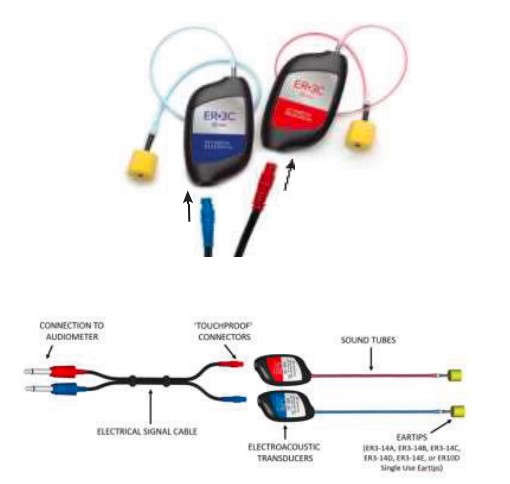
SPECIFICATIONS
| Impedance: | 10 Ohms or 50 Ohms or 300 Ohms |
| Sensitivity: | 102.5 dB SPL in HA-2 coupler at 0.1 Vms (10 Ohms) 102.5 dB SPL in HA-2 coupler at 0.2 Vms (50 Ohms) 102.5 dB SPL in HA-2 coupler at 0.49 Vms (300 Ohms) |
| Temperature: | 15-35º C |
| Relative Humidity: | 30-90% (non-condensing) |
| Ambient Pressure: | 98-104 kPa |
| Maximum Output: | Meets or exceeds 110 dB HL at standard audiometric frequencies between 0.5 and 4kHz |
| Safe Operating Limits: | Maximum continuous sine wave drive: 2.5 Vrms (10 Ohms) 5 Vrms (50 Ohms) 13.75 Vrms (300 Ohms) |
REFERENCES
- American National Standards Institute. ANSI S3.7-1995 (R2008). Methods for Coupler Calibration of Earphones.
- American National Standards Institute. ANSI S3.1-1999 (R2013). Maximum Permissible Ambient Noise Level for Audiometric Test Rooms.
- American National Standards Institute. ANSI S3.6-2010. Specifications for Audiometers
- Botsford JH (1973). How to estimate the dBA reduction of ear protectors. Sound Vib 7(1):32-33.
- International Electrotechnical Commission. IEC 60601-1:2005. Medical Electrical Equipment-Part 1: General Requirements for Safety and Essential Performance.
- International Electrotechnical Commission. IEC 60645-1:2012. Electroacoustics-Audiometric Equipment-Part 1: Equipment for Pure Tone Audiometry
- International Organization for Standardization. ISO 389-2 (1996). Acoustics – Reference zero for the calibration of audiometric equipment. Part 2 – Reference equivalent threshold sound pressure levels for pure tones and insert earphones
- Organization for Standardization. ISO 389-5 )2006). Acoustics – Reference zero for the calibration of audiometric equipment. Part 5 – Reference equivalent threshold sound pressure levels for pure tones in the frequency range 8 kHz to 16kHz.
- Killion MC (1978) Revised estimate of minimum audible pressure. Where is the missing 6dB? J. Acoust Soc. Am, 63 (5), 1501-1508
SYMBOL DEFINITIONS
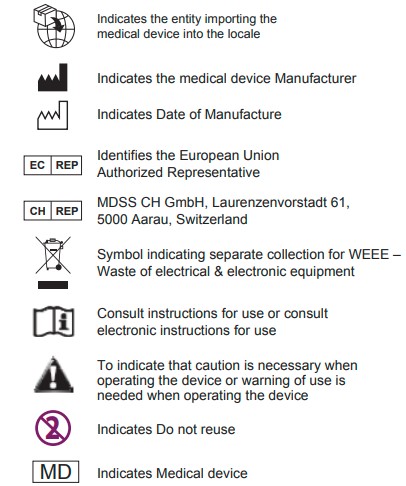
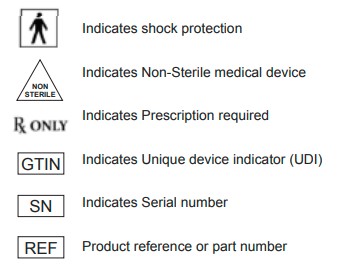
WARRANTY
Etymotic Research, Inc. (ERI) warrants each insert earphone it manufactures to be free of defects in material and workmanship for one year from the date of sale to the original purchaser. Etymotic Research’s obligation under this warranty is fulfilled, at ERI’s option, by replacing the product in kind without charge to the original purchaser, repairing the part, or crediting the original purchaser with the purchase price of the returned defective part. For a part to be covered by the warranty it must be returned to Etymotic Research, postage prepaid, within the warranty period, and the part must not show evidence of misuse, neglect, incorrect wiring by others, or improper installation.
FAQs Etymotic Research ER-3C Insert Earphones
What is the difference between the Etymotic Research ER-3C and other models in the ER series?
The ER-3C is a part of Etymotic Research’s ER series, known for its high-fidelity sound and accuracy. The “C” in ER-3C stands for “Consumer,” indicating that these earphones are intended for consumer use rather than studio or professional use. Unlike some other models in the series (e.g., ER2SE and ER2XR), the ER-3C has a flatter, more neutral sound signature, catering to audiophiles and music enthusiasts who prefer a reference-grade audio experience.
Can I use the Etymotic Research ER-3C earphones with my smartphone?
Yes, you can use the ER-3C earphones with smartphones, tablets, and other audio devices that have a standard 3.5mm headphone jack or an adapter for the 3.5mm jack. These earphones are designed for consumer use and can be enjoyed with various portable audio devices.
What type of ear tips do the ER-3C earphones come with, and are they replaceable?
The Etymotic Research ER-3C earphones typically come with a variety of ear tips, including foam and triple-flange silicone ear tips. These ear tips provide excellent noise isolation and a secure fit. Yes, the ear tips are replaceable, and you can easily find compatible ear tips from Etymotic Research or other third-party manufacturers.
How is the noise isolation performance of the ER-3C earphones?
Etymotic Research is well-known for its noise isolation technology, and the ER-3C earphones excel in this aspect. When fitted correctly with the appropriate eartips, they can provide up to 35-42 dB of noise isolation, effectively blocking out external noise. This level of isolation allows for a more immersive and undisturbed listening experience, even in noisy environments.
Can I use the Etymotic Research ER-3C earphones for stage monitoring or professional use?
While the ER-3C earphones offer accurate sound reproduction, they are primarily designed for consumer use and not specifically optimized for stage monitoring or professional use. Musicians and performers on stage usually require additional features like custom-molded ear tips, detachable cables, and rugged construction, which can be found in dedicated stage in-ear monitors (IEMs).
How durable are the Etymotic Research ER-3C earphones?
The ER-3C earphones are built with high-quality materials and are generally considered durable. However, like any electronic device, proper care and handling are essential to maintaining their longevity. Storing them in the provided carrying case or pouch when not in use and avoiding exposure to extreme temperatures or physical stress can help prolong their lifespan.
Can I wear the Etymotic Research ER-3C earphones while sleeping?
While some users find the ER-3C earphones comfortable enough to wear while sleeping, it’s essential to consider individual preferences and sensitivity while using earphones during sleep. Be mindful of any discomfort or potential issues like ear pressure, and ensure that the fit is not too tight.
Do the ER-3C earphones require a break-in period?
The concept of “burn-in” or break-in period in headphones is a topic of debate among audiophiles. Some believe that headphones may experience subtle changes in sound quality over time as the components settle in during initial use. However, the effect, if any, is usually minimal and not universally agreed upon. You can use the ER-3C earphones right out of the box, and they should provide a high-quality listening experience from the start.
What type of audio driver technology does the Etymotic Research ER-3C use?
The Etymotic Research ER-3C earphones feature high-performance balanced armature drivers. Balanced armature drivers are known for their accuracy and fast response, making them well-suited for delivering precise and detailed sound.
Are the Etymotic Research ER-3C earphones suitable for use during air travel?
Yes, the ER-3C earphones are ideal for air travel due to their excellent noise isolation capabilities. With up to 35-42 dB of noise isolation when properly fitted, they can help block out the ambient noise in airplanes, making your travel experience more enjoyable and less fatiguing.
For more manuals by Etymotic, visit Manualsdock
[embeddoc url=”https://manualsdock.com/wp-content/uploads/2023/07/Etymotic-Research-ER-3C-Insert-Earphones.pdf” download=”all”]

